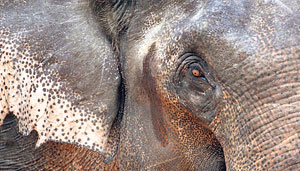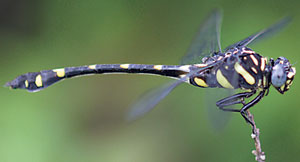Jetwing Senior Operations Executive Ganganath Weerasinghe and I joined the British Dragonfly Society group at Jetwing Vil Uyana and walked around looking at dragonflies and butterflies.
Leading the group was naturalist guide Wicky Wickremesekera, guest expert Karen Conniff and Dan Powell from the UK. Samangi Hewage the naturalist of Hotel Sigiriya also joined us for the dragonfly and butterfly watching session around the man- made wetland at Vil Uyana.
The Wara (Calotropis gigantea) as usual attracted a number of Carpenter Bees. Common Indian Crows, Plain and Common Tigers, Blue Wanderer, Peacock Pansy and other common butterflies were present. We failed to find a Blue Pansy. A Grey-headed Fish-eagle was perched on the balcony of one of the two water chalets. Water was still present in the lake, but levels were low in the peak of the dry season.
A Blue-eyed Pond Cruiser (Epophthalmia vittata) hurtled around. But the dragonfly fauna was thin. So we drove past the hotel to the first wewa on our right. Here we saw Rapacious Flangetail (Ictniogomphosus rapax), an orange form female Common Blutail (Ishnura senegalensis), Amber-winged Glider (Tramea basilaris), Oriental Scarlet (Crocothemis servillia), Sombre Lieutanant (Brachydiplax sobrina), etc.
We also visited a small wewa at the end of the Sigiriya moat. The embankment had several clumps of Lantana and the Brits were overwhelmed by the number and diversity of butterflies. Lemon Emigrant, Albatross, Tailed Jay, Common Mormon, Grass Yellows, Small Salmon Arab, Danaid Eggfly, Chocolate Soldier, Peacock Pansy, etc were all found concentrated within a few tens of metres. They swirled around us either nectaring or engaged in territorial duels. A Common Indian Crow patrolled up and down with its hair pencils erect, wafting pheromones. A species of Lineblue rested in a shaded woodland ride.
One of the highlights here was an endemic Painted-lip Lizard which was spotted about 20-30 plus feet high up on a tree.
 |
| Elephant at Minneriya and (Top) a Rapacious Flangetail (Bottom) |
 |
The north-east monsoons had not arrived yet and we joined the group to visit Minneriya National Park. The road was blocked near the stretch of bamboo by a small group of elephants on the road. Closest to us was an enormous bull in musth. We could see the secretion from the temporal gland. It dribbled urine onto its back legs. The pungent odour had a sweet quality to it. It reminded me of rotting Jak fruit. It approached us and tucked its trunk into its mouth, usually a sign it would charge. But it never did. Two more vehicles pulled in including the dragonfly group who had their first wild elephant at extremely close quarters.
We pressed on in search of a group of elephants whom I hoped to find bathing. I was distracted by wonderful light falling on a group of cormorants of which three of four Great Cormorants were in breeding plumage. The usually black head and neck were frosted in white, the beaks had orange and yellow stripes contrasting against black and white stripes on the head and neck. The eyes were blue. The colours were striking.
On our way out, I spotted high up in the canopy a single Purple-faced Leaf Monkey. It had very little white on its rump and must have been the Northern sub-species.
A Giant Squirrel ran across the road. The mammals seen were Elephant, Grey Langur, Toque Monkey, Grey & Ruddy Mongoose, Barking & Spotted Deer and Black-naped Hare This was a surprisingly rich number of mammals to be seen in an Asian wildlife reserve in just two sessions. At the park office we found two more Giant Squirrels feeding on the fruiting Kohomba.
Gehan de Silva Wijeyeratne is CEO of Jetwing Eco Holidays. He can be contacted on www.jetwingeco.com, Facebook, Twitter and Flickr. |
